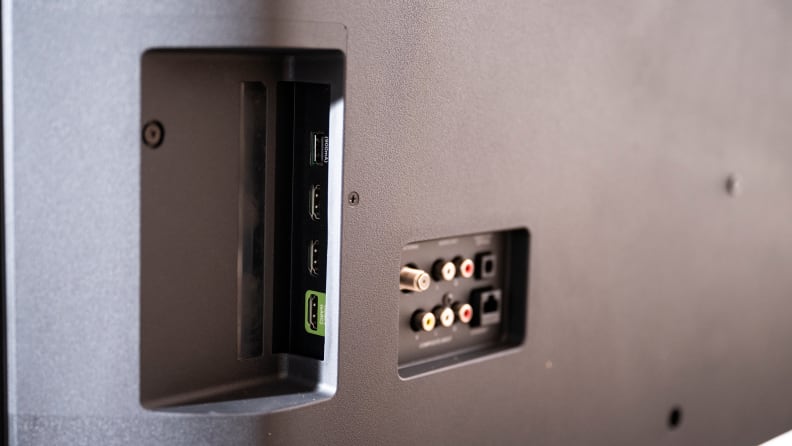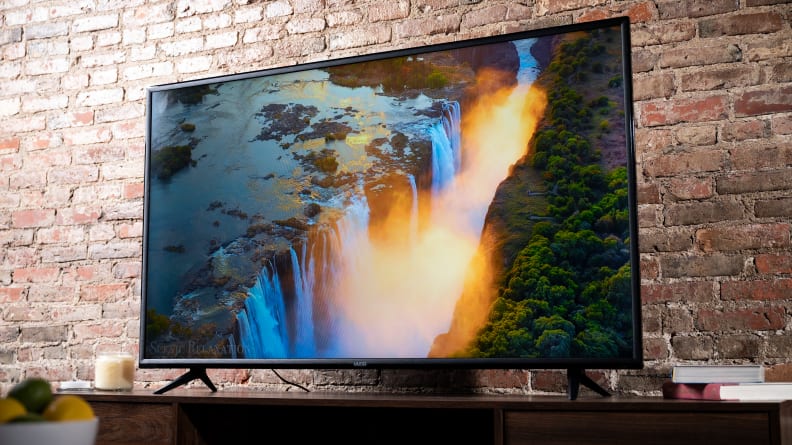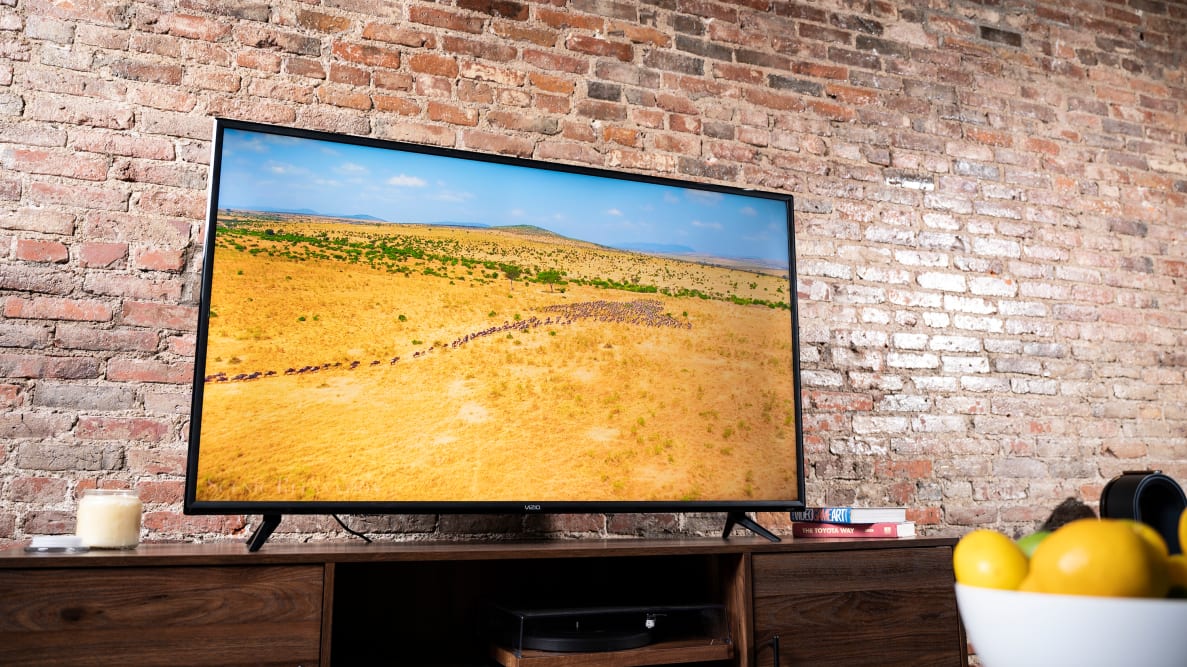Pros
-
Great color
-
Excellent black levels
-
Supports ALLM and eARC
Cons
-
Doesn't get very bright
-
Disappointing smart platform
The V-series’ closest competitors, TCL’s 4-Series and 5-Series, have gone up in price in the last year, most likely due to manufacturing costs. The V-Series—while slightly more expensive at launch than last year’s iteration—remains more affordable.
If you’re upgrading from full HD to 4K, the V-Series will get you there for a low, low cost. It’ll even throw in a couple of cool features, to boot! However, if you’re expecting this TV to deliver the sort of dazzling HDR performance you’ve been hearing so much about, you’ll probably prefer to spend a bit more money on something from TCL or move up to Vizio’s M-Series. In addition, if you’re shopping for a 65-, 70-, or 75-inch TV that will maximize your dollar-to-screen-size ratio, the V-Series’ narrow viewing angles might steer you in a different direction.
About the Vizio V-Series

The V-Series sits in between Vizio's entry-level D-Series and the more-advanced Vizio M-Series.
Similar to this year’s Vizio M-Series and D-Series, the V-Series features two different versions, each with its own selection of size options.
The primary V-Series lineup—referred to as the “V5” V-Series—is available in seven size options ranging from 43 to 75 inches. Alternatively, the “V6” V-Series is available in 70- and 75-inch sizes, both of which include AMD FreeSync for improved gaming performance. The inclusion of FreeSync is the only major difference between the V5 lineup and the V6 lineup.
Our review unit is a 55-inch V5 variant that we received on loan from Vizio. Here’s how the V-Series lineup shakes out for pricing:
- 43-inch (V435-J), MSRP $339.99
- 50-inch (V505-J), MSRP $399.99
- 55-inch (V555-J), MSRP $499.99
- 58-inch (V585-J), MSRP $529.99
- 65-inch (V655-J), MSRP $599.99
- 70-inch (V705-J), MSRP $699.99
- 75-inch (V755-J), MSRP $899.99
While we can’t speak on the performance of the V6 models until we’ve tested them, we don’t expect there to be major differences between those models or the seven V5 models (other than the inclusion of FreeSync).
Here’s a rundown of the V5 V-Series’ basic specs:
- Resolution: 4K (3,840 x 2,160)
- Display type: Full-array direct LED
- HDR support: Dolby Vision, HDR10, HDR10+, HLG
- Dolby Atmos: Yes
- eARC support: Yes
- Native refresh rate: 60Hz
- Smart platform: SmartCast 5.0
- Color: DCI-P3 color space/10-bit chroma resolution
- Variable Refresh Rate (VRR): No
- Auto Low Latency Mode (ALLM): Yes
- Other features: ProGaming Engine, Google Chromecast, Google Assistant, Alexa, Apple AirPlay 2

If you opt for the 65-, 70-, or 75-inch V-Series and you don't plan on mounting it, be sure that your tabletop is wide enough to accommodate the TV's feet.
Like just about every TV in Vizio’s 2021/2022 lineup (except for the hyper-affordable D-Series), the V-Series ships with Vizio’s new, slimmed-down remote control. It features dedicated app buttons as well as a microphone for voice recognition.
If you’ve laid eyes on a Vizio TV in the last few years, you pretty much know what to expect when it comes to the V-Series’ design. The panel is wrapped in charcoal-gray plastic and rests on two angular feet positioned close to its corners. The picture is framed by not-so-narrow bezels on all four sides, though I’m told that the bezel design is slightly different on the V6 variants. If you opt for one of the bigger sizes in this series—particularly the 70- and 75-inch models—make sure you have a wide-enough surface to accommodate its wide-set feet.
Performance data
Before testing each TV, we make sure the panel is on and receiving a continuous signal for at least 24 hours, allowing the pixels plenty of time to warm up. Our 55-inch V-Series received this standard warm-up time before any readings were taken.
For both SDR and HDR tests, we used Vizio’s “Calibrated” picture mode. We’ve chosen this picture setting because of its accuracy, but results may vary depending on which picture mode is enabled. For example, you’re likely to experience a brighter picture on the TV’s “Vivid” picture mode, but this sacrifices color accuracy.
To get a sense for the TV’s average performance, we use a standard ANSI checkerboard pattern for most of our basic contrast tests. We also use white and black windows ranging from 2% to 90% to test how well the contrast holds up while displaying varying degrees of brightness.
Our peak brightness measurements are taken with sustained windows to represent the TV’s peak brightness over a sustained period of time. Specular highlights (like brief flashes of reflected light) might reach higher brightness levels, but not for a sustained period of time.
All of our tests are created with a QuantumData 780A signal generator and tabulated via Calman Ultimate. I'll expand on our test results throughout the review, but for now, here are some key takeaways:
• HDR contrast (brightness/black level): 198.2 nits/0.029 nits (ANSI checkerboard) • SDR contrast (brightness/black level): 197.3 nits/0.029 nits (ANSI checkerboard) • HDR peak brightness (sustained): 199.8 nits (20% white window) • HDR color gamut coverage (DCI-P3/10-bit): 77% • SDR color gamut coverage (Rec.709): 98%
These measurements were taken with the V-Series’ backlight set to “100” and its color temperature kept at “Warm.” For advanced picture settings, “Black Detail” and “Low Contrast” were turned off, “Edge Enhancement” was set to “Low,” and “Backlight Control” was turned on. Additionally, we disabled “Film Mode” for all test procedures.
Connectivity

There are three HDMI 2.1 ports on the back of the Vizio V-Series.
New to the V-Series this year are HDMI 2.1 ports, which support 4K/60fps but not 4K/120fps. Here’s what you’ll find in a cutout on the right side of the V-Series’ back panel:
- 3x HDMI 2.1 (1x eARC)
- 1x USB 2.0
- RF connection (cable/antenna)
- Ethernet (LAN) input
- Digital audio output (optical)
- Composite input
What we like
Accurate out-of-the-box color

In SDR, the V-Series covers about 98% of the Rec.709 color gamut. All told, colors look rich and accurate right out of the box.
Unlike the Vizio M-Series—Vizio’s premium mid-range TV in 2021—the V-Series isn’t equipped with quantum dots, a display technology that enhances color saturation. Nevertheless, while the V-Series isn’t a world-beater when it comes to wide, HDR-worthy color, you can expect accurate, rich color during SDR content, which probably makes up the vast majority of the content you’ll be regularly watching.
In the TV’s “Calibrated” picture mode, the V-Series covers a relatively impressive 98% of the SDR color gamut (Rec.709). No calibration measures were taken before these tests were conducted, meaning you can expect to see similar results right out of the box. All of the SDR content I watched on the V-Series featured terrific color—from 4K YouTube videos to Netflix shows and Blu-rays.
In HDR, the V-Series’ color production looks more or less the same. This means that HDR color doesn’t quite pop the way it ought to, but colors nevertheless look true to life thanks to the accuracy of its Rec.709 color points.
Consistently deep black levels

The V-Series' consistently deep black levels are one of the reasons the TV is a reliable pick for folks who just want a decent picture for a low cost.
Nearly every black level measurement I took while testing the V-Series fell into the 0.02 to 0.04 range—a fantastic series of measurements for one of the most important elements of picture quality. Indeed, the V-Series is quite adept at keeping its black levels in the cellar, and at no point did brighter picture elements lift the shadow tones.
While this is an easier achievement to pull off with inherently dim TVs like the V-Series, it’s worth noting how much of a stabilizing effect this has on a TV with limited range. The V-Series may not get nearly as bright as some higher-end TVs, but its consistently deep black levels allow for a picture that never looks… well, cheap.
Welcome features for gamers on a budget

Only the 70- and 75-inch V6 variants of the Vizio V-Series offer AMD FreeSync, but all of the V-Series TVs offer Auto Low Latency Mode and eARC support.
Despite the limitations of their implementation, the V-Series’ inclusion of HDMI 2.1 ports is a nice addition. The TV is equipped with Vizio’s V-Gaming Engine, and on the V5 V-Series models, this includes Auto Game Mode (Auto Low Latency Mode) and 4K gaming at 60fps. On the 70- and 75-inch V6 models, you’ll find all of these features plus AMD FreeSync.
Unfortunately, FreeSync is not available on the 55-inch V5 V-Series we tested. If you set aside this TV’s lack of FreeSync and Variable Refresh Rate (VRR) available on the extra-large V6 models, it’s a fairly good deal for gamers shopping on a budget, especially since all three of its HDMI ports support Auto Game Mode (including the eARC port). This means that if you intend to use an Xbox Series X, a PlayStation 5, and a soundbar, you don’t have to worry about juggling connections.
Despite most of the V-Series lineup lacking FreeSync, the addition of HDMI 2.1 and Auto Low Latency Mode represents a significant advantage that this TV has over one of its closest competitors, the TCL 4-Series. If you’re planning on gaming, the V-Series is the slightly more accommodating pick.
While nearly all modern TVs support HDMI ARC, the V-Series goes further with HDMI eARC support. This not only offers significantly higher bandwidth capabilities, but also allows you to send uncompressed audio, including one of the most exciting surround formats, Dolby Atmos. directly to an eARC-equipped device, The addition of eARC means the V-Series is more flexible than rivals like the TCL 4-Series due to its ability to take itself out of the the audio-decoding process. When matched with an eARC supported audio device like a Dolby Atmos soundbar, this vastly simplifies audio connection. If you plan on using your new TV well into the future, the V-Series’ simplified approach makes it well-equipped to handle virtually any sound format.
What we don’t like
Lack of brightness spells sub-par HDR

While the above photo was taken with the V-Series displaying SDR content, its HDR performance isn't much different due to the TV's overall lack of brightness.
The V-Series’ Achilles’ heel is its lack of luminance across all use cases. While sending the TV an SDR signal, the highest brightness reading I measured was 197.3 nits. While sending the V-Series an HDR signal, the highest brightness reading I measured was 199.8 nits. Both of these measurements were taken while the V-Series was in its most-accurate picture mode, “Calibrated.”
To test the upper limits of the TV’s luminance, I also ran a series of tests with the V-Series picture mode set to “Vivid.” The highest reading I measured during this series was 220.7 nits. Bear in mind that the TV’s “Vivid” picture mode compromises color temperature accuracy, among other factors. For reference, last year’s V-Series climbed as high as 232 nits in HDR, and it did so in its “Calibrated” picture mode. The TCL 4-Series, meanwhile, performed similarly in its most accurate picture mode, often settling in between 200 and 250 nits.
Because the V-Series’ overall brightness is more or less the same in HDR as it is in SDR, there’s no meaningful distinction between the two formats. Without the added luminance, HDR color production is disappointing, too. I saw it with my own eyes when I switched from SDR content to HDR content on Netflix. The V-Series’ consistently deep black levels and accurate SDR color keep HDR content from looking outright questionable, but anyone hoping to witness the benefits of HDR will be out of luck.
SmartCast is not a robust smart platform

The V-Series comes with Vizio's SmartCast platform pre-installed.
We’ve had our qualms with Vizio’s smart platform software, SmartCast, for a few years now. And while Vizio continues to make minor improvements to the platform—better responsiveness, additional app support, etc.—the total package is quite limited.
High-profile streaming apps like Disney+, Netflix, Hulu, and Amazon Prime Video are pre-installed, but SmartCast doesn’t offer folks much in the way of customizability, and there’s no way to add more apps of your choice to the stable of pre-installed software. There is a fix for the majority of other apps you’d need in the way of “casting” content from your smartphone via the platform’s Chromecast feature, but we’d love to see more onboard options.
There are a couple of good features to hang your hat on, including the aforementioned Google Chromecast and Apple AirPlay 2 support, but SmartCast simply does not offer the flexibility of TCL’s Roku TV platform, or other competitors like LG’s webOS, Samsung’s Tizen smart platform, or Android TV.
Middling motion handling and narrow viewing angles

Motion handling and viewing angles are two areas where the V-Series wears its low cost on its sleeve.
The V-Series and its native 60Hz refresh rate can often cause motion trailing and significant judder, particularly during scenes where a camera pans or tilts across characters, objects, and scenery. These moments can, at times, be very distracting. To be fair, locking down a refresh rate of 120Hz is not going to happen if you’re shopping in this price range, but to my eye, the V-Series’ motion handling isn’t as good as I’ve seen on other 60Hz TVs, such as the aforementioned 4-Series.
The only motion enhancement software offered in the V-Series’ settings menu is “Film Mode,” which reduces judder during 24fps playback when enabled. This helps for native-24fps content, but you won’t find any adjustable motion smoothing options in the picture settings.
Unsurprisingly, due to its VA-style panel, the TV’s vertical and horizontal viewing angles are also quite limited. If you’re sitting even three feet off to the side of a direct angle, the TV’s contrast begins to suffer. For folks seated off to the side, colors will appear to lose some saturation.
Should you buy it?
Yes, but only if you're on a strict budget

The V-Series offers tremendous value for non-fussy shoppers who just want a 4K TV without spending an arm and a leg.
As mid-range TVs steadily rise in cost, the era of budget-friendly TVs that punch above their weight may be entering a new phase. Recently, prices for TCL’s 4-Series, 5-Series, and 6-Series TVs have all spiked—perhaps the result of increased manufacturing costs and supply chain uncertainty. When it debuted in 2020, the 65-inch 5-Series cost $629.99. Today? $899.99.
We might have compared this year’s V-Series to the TCL 5-Series if prices hadn’t changed, but these days, it's closer in price to the TCL 4-Series (which has also gone up in price recently). On one hand, it would've been great if this year's V-Series looked significantly better than last year’s V-Series. On the other, TVs in this class are seemingly going up in price. Vizio has decided that keeping the price of this year’s V-Series down is preferable to offering the same (or better) performance for a higher cost. In other words, TVs at this price are few and far between in 2021, and Vizio is here to remind you that its latest lineup still has you covered—not only that, but you’ve got seven sizes to choose from, too.
That said, it’s important to understand that the V-Series has some serious limitations. For one thing, it’s not capable of delivering an HDR experience worthy of the format’s distinction, and in general, the picture is very dim. This is less of an issue for folks who plan on putting the TV in a dark room, but it might have some trouble hanging in there during daytime use. In addition, the V-Series’ narrow viewing angles—combined with its overall lack of brightness—spells trouble for big-screen bargain hunters. When seen at an off-angle, an eminently affordable 75-inch V-Series in a particularly sunny room might prove to be a sobering sight.
If you’re a casual viewer with an easy-to-please approach, the V-Series is a solid choice. Most of the content you’ll encounter will look good enough—especially if you’re upgrading to 4K resolution for the first time. Plus, there aren’t very many TVs in this price bracket that offer Auto Low Latency Mode, so if you’re a gamer shopping on a budget (and you don’t mind a dim TV), the V-Series is worth a look. If you want a brighter picture and better HDR performance, you’ll have to spend a bit more on something like the TCL 5-Series or the Samsung TU8000, both of which were released last year but can still be found in stores.
Meet the tester
Michael Desjardin graduated from Emerson College after having studied media production and screenwriting. He specializes in tech for Reviewed, but also loves film criticism, weird ambient music, cooking, and food in general.
Checking our work.
Our team is here to help you buy the best stuff and love what you own. Our writers, editors, and experts obsess over the products we cover to make sure you're confident and satisfied. Have a different opinion about something we recommend? Email us and we'll compare notes.
Shoot us an email


